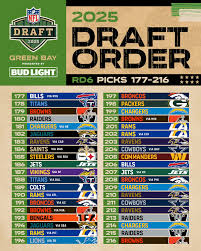NFL Draft 2025: Teams Looking to Move Down, Few Looking to Move Up
SPORT
4/24/20257 min read


Introduction to the 2025 NFL Draft Landscape
The 2025 NFL Draft is shaping up to be a pivotal event for many teams across the league, as they assess their strategies for acquiring top talent and enhancing their rosters. Each year, the draft offers an opportunity for franchises to build for the future by selecting promising players, but the ways in which teams approach this process can vary significantly. In 2025, we observe a clear distinction between teams keen on moving down in the draft order and those intensely aiming to move up.
Understanding the landscape of the draft requires an analysis of draft capital, which has become increasingly critical for teams seeking to fortify their rosters. Those looking to trade down typically possess an eye for accumulating additional picks, providing them enhanced flexibility to address various positional needs in subsequent rounds. Conversely, teams aiming to move up often consist of franchises eager to secure a standout player or address a pressing gap that could improve their chances of success in the upcoming season.
Player rankings will also play a considerable role in the 2025 NFL Draft dynamics. As college football seasons unfold and the scouting process intensifies, the rankings of top prospects are likely to shift, further influencing team decisions. Organizations will need to weigh their immediate needs against overall draft positioning and player evaluations, as they formulate strategies that align with their long-term goals.
Ultimately, the interplay between teams moving down and those aspiring to move up serves as a reflection of the evolving strategies within the NFL. The balancing act of acquiring new talent while ensuring that team requirements are met will be a key theme throughout the 2025 NFL Draft. This ever-changing landscape ensures that the upcoming draft will not only impact the immediate future of franchises but also shape their long-term trajectories.
Teams Interested in Moving Down: Factors at Play
As the NFL Draft 2025 approaches, several teams have displayed a strategic inclination towards moving down in the draft order. This trend is not merely a matter of preference but is influenced by a multitude of factors that underscore their roster dynamics and long-term strategies. One significant reason teams opt to move down is to acquire additional picks, which can help bolster their rosters over upcoming seasons, especially for franchises undergoing rebuilding phases.
For instance, teams with younger rosters may prioritize acquiring additional picks to develop their talent pool further. By trading down, they can obtain a combination of current and future picks, allowing them to secure prospects across various positions that align with their long-term vision. Additionally, teams may focus on depth at specific positions, choosing to forgo a singular high-profile prospect in exchange for the opportunity to draft multiple players who could contribute effectively across various roles.
Another crucial factor at play involves the evaluation of the draft class itself. As teams analyze the strengths and weaknesses of available prospects, some may determine that the depth in certain positions is more advantageous than selecting at a higher draft spot. For example, if a team recognizes that multiple players at their targeted position are projected to be available later in the draft, they might opt to trade down to maximize their chances of acquiring one of those players while also collecting additional assets.
A further consideration includes the existing team's overall direction and management's willingness to adapt tactics based on their assessment of the roster's current state. In summary, the decision to move down in the draft order is multifaceted, reflecting a mixture of strategic foresight, roster needs, and the pursuit of long-term success through leveraging future draft capital.
Key Benefits of Trading Down in the Draft
In the context of the NFL Draft, trading down has become a strategic maneuver employed by numerous teams looking to enhance their roster. One of the primary advantages of this approach is the opportunity to acquire multiple draft picks. By moving down in the draft order, teams can not only obtain their targeted player but also gain additional selections in subsequent rounds. This ability to secure multiple picks can significantly bolster a team's depth and versatility. For example, teams may use these extra selections to address multiple positional needs, a tactic that can lead to a more well-rounded and competitive roster.
Another benefit of trading down is the flexibility it grants teams in addressing their roster construction. In an era where injuries and performance variability can heavily impact team success, having a broader selection of players allows teams to be more adaptable. For instance, a team that trades down may focus on acquiring young talent at various positions instead of singularly targeting a high-profile prospect. This comprehensive approach can be particularly beneficial when evaluating talent across different positions in deep drafts.
Historical examples illustrate the triumphs associated with moving down in the draft. The 2017 NFL Draft, for example, featured a significant trade by the Chicago Bears, who moved up in exchange for their first-round pick. Conversely, the San Francisco 49ers capitalized on this trade by acquiring multiple selections, which they later used to address various roster needs. The outcome? Enhanced performance in subsequent seasons, showcasing the potential long-term benefits of trading down. Ultimately, this strategy not only deepens the roster but also positions the team for sustained success by allowing more opportunities to find hidden gems in the draft process.
Teams Looking to Move Up: Identifying Key Contenders
As the NFL Draft 2025 approaches, the competitive landscape is evolving, prompting various teams to consider moving up in the draft order. This strategy is often employed by franchises that have identified the scarcity of elite talent available at specific positions crucial for their roster. Furthermore, immediate playoff aspirations may dictate a team's urgency to secure game-changing prospects that can contribute instantly. The combination of these factors has created a heightened interest in ascending the draft board.
One team that could be looking to move up is the Chicago Bears. After a rebuilding phase, they may want to expedite their progress by targeting a franchise-altering quarterback or a standout wide receiver. With their rich stash of draft capital, the Bears have the resources to make a significant leap, especially if they set their sights on players like Caleb Williams or Marvin Harrison Jr. Both prospects carry immense potential and could be pivotal in shaping the team's future.
The Atlanta Falcons are in a similar position, as they seek to enhance their offense and solidify their defense. The Falcons might look for key defensive talents to complement their young roster. If they feel that a particular defensive lineman or cornerback could shift the balance in their favor, moving up could be justified. Their motivation stems not just from securing talent, but also from their aspirations of making a deep playoff run.
Additionally, the New York Giants may opt to ascend the draft order with the aim of securing offensive line talent. Such a move would demonstrate their commitment to protecting their quarterback and establishing a stable foundation. Overall, multiple teams are eyeing opportunities to trade up, each with distinct motivations centered on securing elite players who could potentially alter their franchise trajectories.
Implications of Trades on Draft Night
The NFL Draft is an event that significantly impacts the future of franchises, and trades during draft night can reshape the landscape of player distribution across the league. When teams choose to trade up, they often do so to secure a higher-rated prospect, thus potentially shifting the level of talent a team can offer. This movement can create a domino effect where teams that trade down may find themselves with additional picks, allowing them to build depth or target emerging needs. As a result, the overall talent distribution becomes more dynamic and strategic, with teams aggressively planning their moves to maximize value.
Moreover, fan expectations play a crucial role in how trades are perceived on draft night. A trade that brings a coveted prospect to a franchise can invigorate fan enthusiasm and heighten engagement. Conversely, if a team trades down, there may be concerns about losing immediate impact players, which can lead to disappointments among the fanbase. Consequently, the emotional impact of these trades extends beyond management decisions; it influences public sentiment and brand perception significantly.
Historical Context: Past Draft Trade Trends
The landscape of the NFL Draft has evolved significantly over the years, with teams frequently engaging in trades either to move up for coveted prospects or to move down for additional assets. Historical analysis reveals that most teams have adopted varied strategies based on their specific needs, potential future outlooks, and the overall strength of the draft class. Notably, the drafts of 2012 and 2016 provide insightful case studies into these trading patterns.
In the 2012 NFL Draft, the Washington Redskins executed one of the most renowned trades in draft history when they moved up from the sixth to the second overall pick to select quarterback Robert Griffin III. This significant maneuver exemplified a trend where teams deemed in need of a franchise quarterback were willing to sacrifice future assets for immediate impact players. However, while this move initially appeared promising, it ultimately led to disappointment, as Griffin's performance did not meet the high expectations set during the draft.
Conversely, the 2016 draft showcased several teams successfully trading down to accumulate additional picks that fortified their rosters in subsequent years. The Cleveland Browns, for instance, moved from the second to the eighth pick, acquiring extra selections that would eventually aid in rebuilding their team. This strategy of accumulating assets to build a more profound, talented roster proved advantageous over time as it allowed teams to address multiple weaknesses.
Overall, historical trends indicate that while trading up can lead to immediate rewards, moving down often offers longer-term benefits by affording teams the chance to select multiple prospects. As the 2025 NFL Draft approaches, teams will undoubtedly analyze past drafts' lessons, balancing the urgency of immediate success against the potential benefits of a diversified approach in building their franchises.
Conclusion: Predictions and Final Thoughts
The 2025 NFL Draft is shaping up to be a pivotal event for teams across the league, reflecting the evolving strategies and operational dynamics characteristic of professional football. As the draft approaches, key insights have emerged regarding the intentions of various franchises, particularly with respect to their draft positions. A notable trend is the inclination of several teams to move down in the draft order, seeking to accumulate more assets for the future. Conversely, a select few organizations are poised to capitalize on potential trades, aiming to ascend the draft board to secure high-impact players essential to their long-term success.
The shifting dynamics of the 2025 NFL Draft correlate significantly with the broader landscape of team compositions, player evaluations, and the competitive nature of the league. Teams are increasingly adopting flexible strategies, as they seek to optimize their chances of acquiring young talent. The emphasis on adaptable approaches is crucial, as it allows organizations to respond effectively to the decisions made by rivals. Executives are weighing the short-term benefits of securing immediate contributors against the merits of accumulating various picks that could be useful in the future.
As predictions unfold, it's important to keep an eye on teams with an eye toward moving up, particularly those with established rosters aiming to bolster key positions. In this environment, where strategic foresight can dictate success, it is evident that adaptability will play a critical role in determining outcomes. The 2025 NFL Draft promises to be dynamic, and the decisions made will not only shape immediate team performance but also influence the league's trajectory for years to come.
